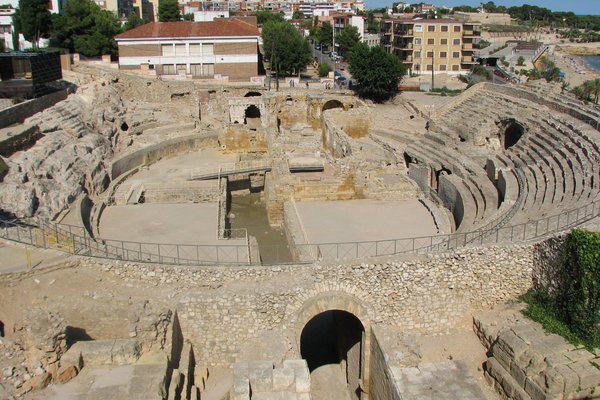Spain
Tarraco
The Archaeological Ensemble of Tarraco reflects the first and oldest Roman settlement on the Iberian Peninsula.
It first served as a base for the conquest of the interior and then became a provincial capital. The city has been built on three terraces, adapting to its environments, and includes a Forum, Circus, Amphitheatre, villas and other public buildings. Its remains also illustrate the entire Roman period of the town, from the 3rd century BCE to the Early Christian Era and the end of Roman rule.
Community Perspective: Tarragona is an easy day trip from Barcelona. There are no real outstanding sights among its Roman remains, but the ensemble shows a complete cross-section of a Roman city. Several components lie quite far outside the city centre; of those the Ferreres Aqueduct and the Quarry of El Mèdeol are recommended for a visit.
Site Info
Official Information
- Full Name
- Archaeological Ensemble of Tarraco (ID: 875)
- Country
- Spain
- Status
-
Inscribed 2000
Site history
History of Tarraco
- 2021: Name change
- From "Archaeological Ensemble of Tárraco" to "Archaeological Ensemble of Tarraco"
- 2000: Inscribed
- Inscribed
- 1998: Requested by State Party to not be examined
- Withdrawn by Spain after ICOMOS recommended Rejection
- Type
- Cultural
- Criteria
- ii
- iii
Links
- UNESCO
- whc.unesco.org
- Official
-
- tarragonaturisme.cat — Tarragona Turisme World Heritage
- Related
-
- mnat.cat — MNAT
- livius.org — Tarraco - by Livius, Articles on Ancient History
- tarragona.cat — Museu d'Història de Tarragona
All Links
UNESCO.org
- whc.unesco.org — whc.unesco.org/
Official Website
- tarragonaturisme.cat — Tarragona Turisme World Heritage
Related Resources
- mnat.cat — MNAT
- livius.org — Tarraco - by Livius, Articles on Ancient History
- tarragona.cat — Museu d'Història de Tarragona
News Article
- March 10, 2010 barcelonareporter.com — Archaeological find Roman baths unearthed in Tarragona
Community Information
- Community Category
- Archaeological site: Ancient Rome
Travel Information
Catalonia hotspot
Recent Connections
-
Locations for playing sport
Roman circus -
Depicted in Mizielinska Maps
Roman amphitheatreSee i.pinimg.com
-
Name changes
From "Archaeological Ensemble of Tárrac…
Connections of Tarraco
- Geography
- Trivia
-
-
Depicted in Mizielinska Maps
Roman amphitheatreSee i.pinimg.com
-
- History
-
-
Ancient Roman colonies
Tarraco
-
- Architecture
-
-
Mosaic art
Villa dels Munts, Villa-mausoleum Centcelles -
Art Nouveau
Mausoleu de Jaume I in the Town Hall, in core zone of component 'Circus'
-
- Religion and Belief
-
-
Devil's Bridge
Ferreres Aqueduct (locally known as the Devil's Bridge) -
Early Christianity
Paleo Christian Cemetery
-
- Human Activity
-
-
Locations for playing sport
Roman circus -
Man-made Terraces
built on terraces
-
- Constructions
-
-
Triumphal Arches
Triumphal Arch of Ber -
Necropolises
Paleochristian necropolis -
Walled cities
-
Aqueduct
-
Theatres and Opera Houses
Roman theatre -
Tombs
Tower of the Scipios -
Roman amphitheatres
Roman amphitheatre
-
- Timeline
-
-
Built in the 3rd century BC
Tárraco "was seized and fortified by the Roman proconsul Scipio Africanus in 218 BC ... The surviving remains of Tárraco make it possible to study the spread of Roman rule from the 3rd/2nd century BC, when the Roman town was founded, until the early Christian period." Its remains cover the entire Roman period through to 3C AD
-
- WHS Hotspots
-
-
Catalonia hotspot
1h15 by train
-
- WHS Names
-
-
Roman Province in its official title
Hispania Tarraconensis. Created 27BCSee en.wikipedia.org
-
Name changes
From "Archaeological Ensemble of Tárraco" to "Archaeological Ensemble of Tarraco" (2021)
-
News
- barcelonareporter.com 03/10/2010
- Archaeological find Roman baths un…
Recent Visitors
Visitors of Tarraco
- 2Flow2
- Afshin Iranpour
- Alexander Lehmann
- Alikander99
- A. Mehmet Haksever
- Ammon Watkins
- Ana
- Ana Lozano
- Anna Wludarska
- Antonio J.
- Argo
- arnaugir
- AS
- Aspasia
- Atila Ege
- BaziFettehenne
- Bill Maurmann
- Bin
- Bodil Ankerly
- Boj
- Bruno_Pires
- campmany
- Can SARICA
- Caspar
- Catoplayer
- Cezar Grozavu
- cflw
- chenboada
- Christravelblog
- Claire Bradshaw
- Clyde
- Cobaltrage
- Cristina Erba
- Csaba Nováczky
- CugelVance
- dana144
- Daniela Hohmann
- Daniel Chazad
- Dan Pettigrew
- David Aaronson
- David Berlanda
- Dennis Nicklaus
- Dimitar Krastev
- Dimitrios Polychronopoulos
- Dirk-pieter
- Dolemite92
- Dorejd
- Dr. Caligari
- Dwight Zehuan Xiao
- Echwel
- Elaine McArdle
- eljx1988
- Elliot
- Els Slots
- Emilia
- Emili Xaus
- Erik Jelinek
- Eva Kisgyorgy
- Evgenii
- Fan Yibo
- Farinelli
- Femke Roos
- Filip Murlak
- forest80
- Gary Arndt
- Geert Luiken
- GeorgeIng61
- Gernot
- Glenn Nightingale
- grimloch
- Grzegorz Andruszkiewicz
- Harald T.
- Harry Mitsidis
- Hubert
- Hughes1920
- Iain Jackson
- Ilya Burlak
- Ivan Rucek
- Jana and Matt
- janameerman
- Jan Zimmermann
- Jasam
- Javier
- Jawnbeary
- Jean Lecaillon
- Jeanne OGrady
- Jens
- Jezza
- João Aender
- Joel on the Road
- Jonas Hagung
- Jonas Kremer
- jxrocky
- Karito Vies
- Kevin Padley-Knight
- kiank37
- kjluebke
- Klaus Freisinger
- Knut
- krtek
- Lara Adler
- Lisu Marian
- Loic Pedras
- Luboang
- Lucio
- Luis Filipe Gaspar
- Maciej Gil
- Małgosia Łupicka
- Manuelfunk
- marcel staron
- Martinacurra88
- Martina Rúčková
- Marty
- Mathijs
- Matthewsharris
- MaYumin
- MH
- Michael Novins
- Michael Turtle
- Mikko
- Milan Jirasek
- MMM
- Msarmiento1979
- Mstrebl1990
- nan
- Niall Sclater
- Nihal Ege
- nikolamus
- Nuria8
- PabloNorte
- Paola Laura
- Patrik
- Paul Schofield
- PeterH
- Peter Lööv
- Petteri
- Philipp Peterer
- Pink Bunny
- Porcho
- Randi Thomsen
- Reza
- Rob Wilson
- Roger Ourset
- Roman Bruehwiler
- Sabrina Liebehentschel
- Sandra!
- serghei.belous
- Sergio Arjona
- Shandos Cleaver
- Simonh
- sncjob
- Solivagant
- Sorel Americo
- Stanislaw Warwas
- StaziG
- Svein Elias
- Szucs Tamas
- Tamara Ratz
- Taotao Chen
- Tarquinio_Superbo
- Tevity
- Thomas Buechler
- Thomas Harold Watson
- Thomas van der Walt
- Tim Allen
- Tonisan
- tony0001
- triath
- ValiaVeweth
- Vanessa Buechler
- Vincent Cheung
- VLabhard
- voyager
- Walter
- WILLIAM RICH
- Wojciech Fedoruk
- Xander Huang
- Xiong Wei
- Xiquinho Silva
- YaroMir
- Zach
- Zoë Sheng
- Zos M
Community Reviews
Show full reviews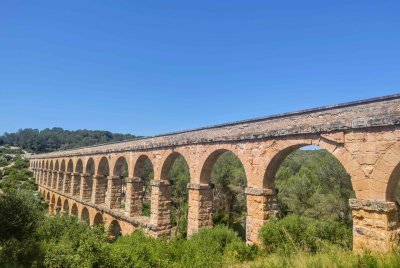
For me, Tarraco (Tarragona as it is called today) is a light 3.5 stars for me, bordering on a 3. As you can gather from the other reviews on here, none of the individual locations are particularly jaw-dropping for this WHS, but taken together they make up quite an interesting vision of Roman life. Also, the fact that this is one of the first Roman settlements not only in Spain, but outside of Italy as a whole is just plain cool.
Tarragona has done a decent job of making each of these locations accessible and providing explanations of what you're seeing via signage and audiovisual displays at each of them. If you want to just hit the biggest highlights and avoid the stuff that are mostly just "rocks" or a piece of hardly-identifiable architecture, then I recommend doing the Amphitheatre, the Circus, the Walls, and the Aqueduct. This is more or less what my group did, as we were limited on time and there is only so much I can convince my non-WHS friends to go out of their way for. Of all these items I'd say the Aqueduct was the most impressive but the Circus really surprises with its unassuming entrance and then vast network of ruins to see once you're inside.
Be aware that most (not all) of these locations you will have to pay separate entrance fees for, so it can get slightly spendy if you're trying to hit all of …
Keep reading 0 comments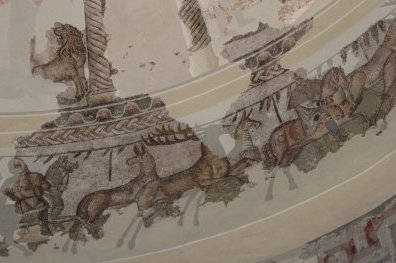
Tarraco is messy proposal with a lot of parts to it, just like the equally hispano roman city of Merida. Over the course of two days I visited the amphitheatre, the circus, the aqueduct and the mausoleum (?) of centcelles. I also visited other properties like the forum and theatre, but their conservation state is pretty terrible.
The most famous element of the site is whithout a doubt the amphitheatre. it's pretty and very photogenic, but it pales in comparison with other city enclosed amphitheatres like arles, verona or pula. This is not all too surprising, afterall Tarraco is inscribed because of its ensemble, but I think the fact that the crown jewel is not overly impressive speaks volumes about the general quality of the site.
The part I enjoyed the most was, as I expected, the roman villa of centcelles (photo). The ticket to fame of this otherwise plain building is its dome partially decorated with mosaics. Not much is known about its history, which has led to much confussion over what to even call it. The whole complex seems to have grown out of a villa, but its evolution across time is a mystery. Some say the domed hall was a basilica, some say it was a mausoleum. The truth is that we don't have any idea why such a luxurious construction (the dome is 10m tall and 10.6m in diameter) was built in the middle of nowhere. However the preservation of a dome mosaic from …
Keep reading 0 comments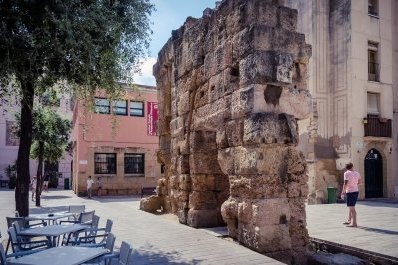
An attractive city to the south-west of Barcelona, Tarragona’s claim to UNESCO recognition revolves around its Roman past, as evidenced by a significant number of architectural remains in and around the city. Its long history means that the medieval, Renaissance, and modern architecture coexist with the remnants of Roman glory. Find yourself in the Plaça del Forum for the best example of that: a standalone fragment of the erstwhile Forum walls surrounded by much later architecture.
On my visit to town in the summer of 2016, I stopped by a number of locations named in the UNESCO description. A walk along city walls is both pleasant and educational, with a lot of information about the city history displayed on stands along the path (in several languages, English included). The walls were built up from different types of materials in different eras, fascinating in their own right.
I also explored the Circus, with ruins on the ground level and several impressive spaces underground. Amphitheater can be seen from a number of points above it, and I decided to limit myself to the exterior observation.
Less than 10 minutes away from the town center is, for me, the most impressive of the surviving Roman monuments, an aqueduct that bears the name of Ponte del Diablo. Walking across it was among the highlights of my trip. The aqueduct sits in a natural park that practically knocked me out with the smells of pine needles and flowers. Nature lovers will find …
Keep reading 0 comments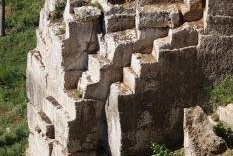
Coming from Barcelona Tarragona was the first stop on our trip through Catalonia in May 2014 and we managed to visit all 14 locations of the archaeological ensemble of Tarraco. I agree with other reviewers that Tarraco is not a brilliant WHS, there are far better examples of Roman arches, amphitheatres, villas and aqueducts on the WH list. But the special feature in Tarragona is the variety of monuments, there are traces of almost every aspect of an ancient metropolis. In this regard Tarraco is similar to Mérida, but I have not yet visited Mérida, so I cannot compare. A detailed model of Roman Tarraco at its heyday in the 2nd century A.D. provides a good impression of the size and the splendour of the ancient city. The model is shown at the Antigua Audiència (3, Placa del Pallol).
First we visited the sites outside the modern city of Tarragona, they are located north of the city and to the east along the route to Barcelona. I liked best the Aqueduct de les Ferreres (Pont del Diable) and the Quarry of El Mèdeol. Both are right off the motorway, you must not pass the toll station. The two-storey aqueduct is less impressive than the one in Segovia or the Pont du Gard, but it is well preserved and we enjoyed to cross the small valley on the top level.
There are several ancient quarries around Tarragona, El Médeol (accessible via the Médeol service area) is considered the most striking. The …
Keep reading 0 comments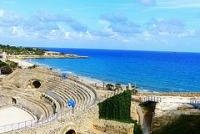
I visited this WHS in May 2014. Before heading towards the city proper, I stopped at the Pont de Diablo park (also known as Pont de les Ferreres) to see the Roman Aqueduct. The park itself is in a rather pitiful state although there are signs which state that there should be an EU funded project underway soon to bring the park back to its former glory. The aqueduct itself though has already been restored and it is in good condition. You can also walk on top of it from one side to the other. It's an interesting stop but the aqueduct is definitely not as grand as the Pont du Gard in France or the one in Segovia, Spain. Later on, I proceeded to the city to visit the other inscribed archaeological remains. The most noteworthy of them is the Roman Amphitheatre and although it isn't the best I've seen so far, its position in front of Playa El Milagro and the Mediterranean sea make it quite picturesque. I enjoyed my day trip in Tarragona however this isn't anywhere near Spain's best WHS nor is it one of the world's best WHS for Roman remains.
Keep reading 0 comments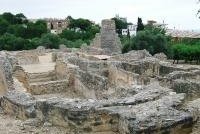
I agree that the listed sites within the city are nothing spectacular compared to Merida so I went to search out the sites on the periphery of the city.
The aqueduct, known locally as Puente del Diablo, is in a leafy park to the north of the city, reached by bus #5 from the city centre. Whilst it is in a good state of repair it nowhere near as spectacular as the one in Segovia.
Centcelles villa is at the village of Constanta, reached by the Plana bus. The main feature is the mosaic design on the domed ceiling of the basilica.
Els Munts, located a short walk from Altafulla station, is a rather disappointing excavated village.
The Arch of Bera, accessed by a Penedes bus from Torredembarra station, is a rather forlorn and incomplete monument.
Keep reading 0 comments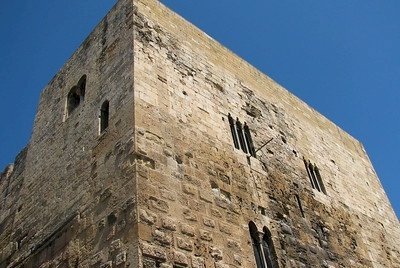
About 95 km south of Barcelona, also on the coast, lies the pleasant city of Tarragona. After leaving our car in a parking garage, we tried to find our way to the Roman remains without a map. This wasn't easy, as the city is spread out along the coastline. Fortunately, the woman at the train station who had sold out all of her maps pointed us in the right direction: most of the sights are in the north, in the upper town. We walked up there, in the midday heat.
The Tourist Information in this part of town holds very Spanish opening hours (closed between 1 and 5 p.m. or so), so we just had to follow our own instincts. The enormous city walls can't be overlooked though. From there we roamed the narrow streets of the charming old town. Most of the Roman remains are only fragments. The amphitheatre is quite complete, but I've seen better ones. It was closed too, for unclear reasons. Not part of the WHS but worth a mention: the cathedral of Tarragona, also in the upper town, is just great.
On our way back to Barcelona (via the A7 toll road) we had a glimpse of the Roman aqueduct. If you're in the mood, there's a small parking lot on both sides of the road from where you can have a good look and take pictures. We'd had enough however after another satisfying day. Advice for future travellers to Tarragona: bring your …
Keep reading 0 comments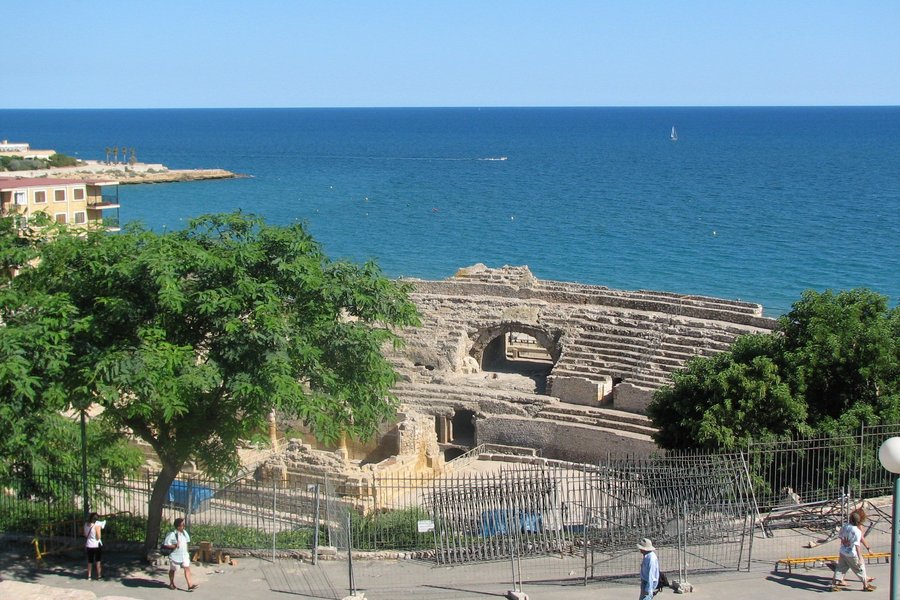
Today's Tarragona is a very nice and quiet city on the coast just an hour south of Barcelona, and a very easy day trip, due to its great coastal location, medieval city center, and, of course, its Roman remains. Two millennia ago, this was Tarraco, the most important city in the Spanish provinces (and capital of Hispania tarraconensis, the largest province on the peninsula), and it's easy to see why the Romans chose this site for their capital. There are no really outstanding sites here, but what makes Tarragona very interesting and maybe even unique is the fact that it features a complete cross-section of a Roman city - it has an amphitheatre, a forum, a circus, a theatre, temples, administrative and residential buildings, defensive walls, a cemetery, a mausoleum, an aqueduct, and a triumphal arch. Most of these are rather well preserved. I especially liked the circus complex, the forum, and the amphitheatre. Several sites are outside the city centre (some quite far away). Of these, I visited the Tower of the Scipios (a funerary monument, not that interesting) and the Ferreres Aqueduct (locally known as the Devil's Bridge, set in a forest and very well preserved). The cathedral is also very impressive, but was closed when I was there. I have visited Tarragona twice, and my second visit in 2012 was much more exhaustive than the first one in 2005, which was just a brief excursion from Barcelona. I really liked the city, and if you are interested …
Keep reading 0 comments
I wouldn't call Tarragona one of the most significant WHS, but is a lovely place to visit. The sites are all in good condition, although the ampitheatre needs some rather unsightly and unnecessary barriers removed, and the forum needs a little tidying. The entrance fees are very reasonable, and you won't be over-run with crowds. The forum was a particularly rewarding experience - I was the only person there!
If you're in the area they are well worth a visit.
Keep reading 0 comments
